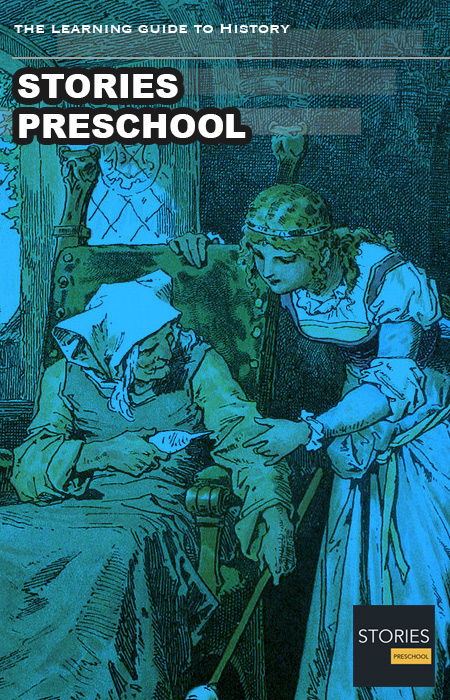Sleeping Beauty
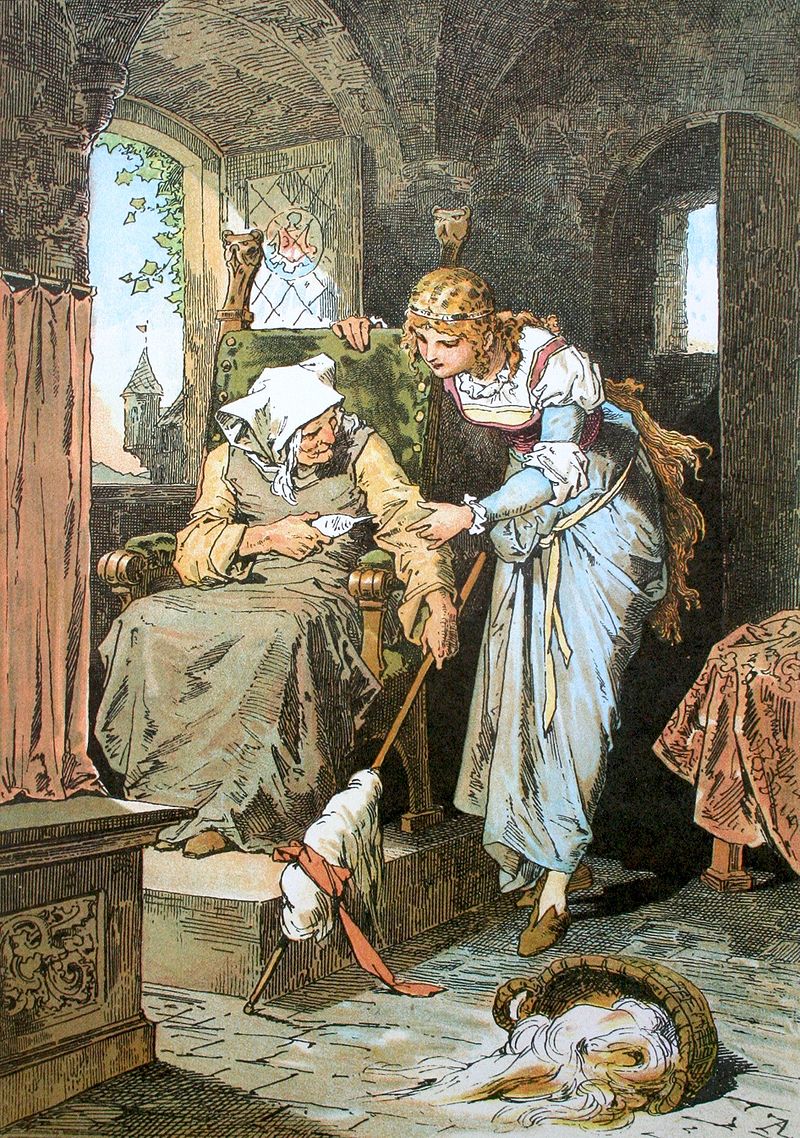
"Sleeping Beauty" (French: La Belle au bois dormant "The Beauty Sleeping in the Wood") by Charles Perrault or "Little Briar Rose" (German: Dornröschen) by the Brothers Grimm is a classic fairy tale written by Charles Perrault and the Brothers Grimm, which involves a beautiful princess, a sleeping enchantment, and a handsome prince. The version collected by the Brothers Grimm was an orally transmitted version of the originally literary tale published by Charles Perrault in Histoires ou contes du temps passé in 1697. This in turn was based on Sun, Moon, and Talia by Italian poet Giambattista Basile (published posthumously in 1634), which was in turn based on one or more folk tales. The earliest known version of the story is Perceforest, composed between 1330 and 1344 and first printed in 1528.
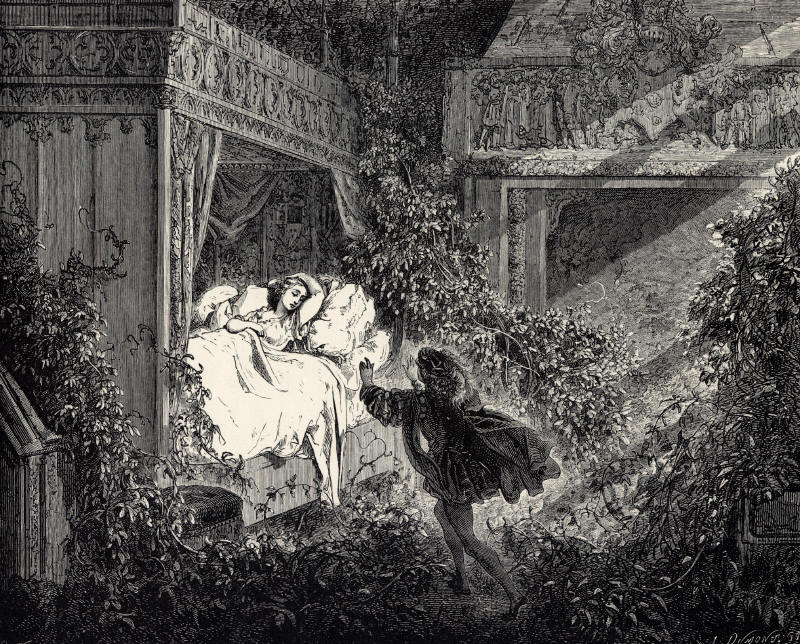
Illustration for Charles Perrault's La Belle au Bois Dormant from Histoires ou Contes du Temps passé: Les Contes de ma Mère l'Oye (1697). Gustave Doré's illustrations appear in an 1867 edition entitled Les Contes de Perrault. Sixth of six engravings

Illustration for Charles Perrault's La Belle au Bois Dormant from Histoires ou Contes du Temps passé: Les Contes de ma Mère l'Oye (1697). Gustave Doré's illustrations appear in an 1867 edition entitled Les Contes de Perrault. Sixth of six engravings
( Click image to enlarge)
Perrault’s narrative
Perrault’s narrative is written in 2 parts. Some folklorists believe that the two parts were originally separate tales, as they were in the Grimms', and were joined together by Basile and once more by Perrault.
Part one
At the christening of a king and queen's long-wished-for child, seven good fairies are invited to be godmothers to the infant princess. The fairies attend the banquet at the palace. Each fairy is presented with a golden plate and drinking cups adorned with jewels. Soon after, an old fairy enters the palace and is seated with a plate of fine china and a crystal drinking glass. This old fairy is overlooked because she has been within a tower for many years and everyone had believed her to be deceased. Six of the other seven fairies then offer their gifts of beauty, wit, grace, dance, song, and goodness to the infant princess. The evil fairy is very angry about having been forgotten, and as her gift, enchants the infant princess so that she will one day prick her finger on a spindle of a spinning wheel and die. The seventh fairy, who hasn't yet given her gift, attempts to reverse the evil fairy's curse. However, she can only do so partially. Instead of dying, the Princess will fall into a deep sleep for 100 years and be awakened by a kiss from a king's son.
The King orders that every spindle and spinning wheel in the kingdom to be destroyed, to try to save his daughter from the terrible curse. Fifteen or sixteen years pass and one day, when the king and queen are away, the Princess wanders through the palace rooms and comes upon an old woman, spinning with her spindle. The princess, who has never seen anyone spin before, asks the old woman if she can try the spinning wheel. The curse is fulfilled as the princess pricks her finger on the spindle and instantly falls into a deep sleep. The old woman cries for help and attempts are made to revive the princess. The king attributes this to fate and has the Princess carried to the finest room in the palace and placed upon a bed of gold and silver embroidered fabric. The king and queen kiss their daughter goodbye and depart, proclaiming the entrance to be forbidden. The good fairy who altered the evil prophecy is summoned. Having great powers of foresight, the fairy sees that the Princess will awaken to distress when she finds herself alone, so the fairy puts everyone in the castle to sleep. The fairy also summons a forest of trees, brambles and thorns that spring up around the castle, shielding it from the outside world and preventing anyone from disturbing the Princess.
A hundred years pass and a prince from another family spies the hidden castle during a hunting expedition. His attendants tell him differing stories regarding the castle until an old man recounts his father's words: within the castle lies a beautiful princess who is doomed to sleep for a hundred years until a king's son comes and awakens her. The prince then braves the tall trees, brambles and thorns which part at his approach, and enters the castle. He passes the sleeping castle folk and comes across the chamber where the Princess lies asleep on the bed. Struck by the radiant beauty before him, he falls on his knees before her. The enchantment comes to an end by a kiss and the princess awakens and converses with the prince for a long time. Meanwhile, the rest of the castle awakens and go about their business. The prince and princess are later married by the chaplain in the castle chapel.
Part two
After wedding the Princess in secret, the Prince continues to visit her and she bears him two children, Aurore (Dawn) and Jour (Day), unbeknown to his mother, who is of an ogre lineage. When the time comes for the Prince to ascend the throne, he brings his wife, children, and the talabutte ("Count of the Mount").
The Ogress Queen Mother sends the young Queen and the children to a house secluded in the woods and directs her cook to prepare the boy with Sauce Robert for dinner. The kind-hearted cook substitutes a lamb for the boy, which satisfies the Queen Mother. She then demands the girl but the cook this time substitutes a young goat, which also satisfies the Queen Mother. When the Ogress demands that he serve up the young Queen, the latter offers to slit her throat so that she may join the children that she imagines are dead. While the Queen Mother is satisfied with a hind prepared with Sauce Robert in place of the young Queen, there is a tearful secret reunion of the Queen and her children. However, the Queen Mother soon discovers the cook’s trick and she prepares a tub in the courtyard filled with vipers and other noxious creatures. The King returns in the nick of time and the Ogress, her true nature having been exposed, throws herself into the tub and is fully consumed. The King, young Queen, and children then live happily ever after.
Basile's narrative
In Giambattista Basile's version of Sleeping Beauty, the Sleeping Beauty is named Talia. By asking wise men and astrologers to predict her future after her birth, her father who is a great lord learns that Talia will be in danger from a splinter of flax. The splinter later causes what appears to be Talia's death; however, it is later learned that it is a long, deep sleep. Unlike the version of Sleeping Beauty known today, Basile's version consists of a more gruesome plot. After the Sleeping Beauty named Talia falls into deep sleep, she is seated on a velvet throne and her father, to forget his misery of what he thinks is her death, closes the doors and abandons the house forever. One day, while a king is walking by, one of his falcons flies into the house. The king knocks, hoping to be let in by someone, but no one answers and he decides to climb in with a ladder. He finds Talia alive but unconscious, and after crying aloud that he is unable to wake her, he carries her to a bed and rapes her. Afterwards, he leaves her in the bed and goes back to his kingdom. Though Talia is unconscious, she gives birth to twins — one of whom keeps sucking her fingers. Talia awakens because the twin has sucked out the flax that was stuck deep in Talia's finger. When she wakes up, she discovers that she is a mother and has no idea what happened to her. One day, the king decides he wants to go see Talia again. He goes back to the palace to find her awake and a mother to his twins. He informs her of who he is, what has happened, and they end up bonding. After a few days, the king has to leave to go back to his realm, but promises Talia that he will return to take her to his kingdom.
When he arrives back in his kingdom, his wife hears him saying "Talia, Sun, and Moon" in his sleep. She bribes and threatens the king's secretary to tell her what is going on. After the queen learns the truth, she pretends she is the king and writes to Talia asking her to send the twins because he wants to see them. Talia sends her twins to the "king" and the queen tells the cook to kill the twins and make dishes out of them. She wants to feed the king his children; instead, the cook takes the twins to his wife and hides them. He then cooks two lambs and serves them as if they were the twins. Every time the king mentions how good the food is, the queen replies, "Eat, eat, you are eating of your own." Later, the queen invites Talia to the kingdom and is going to burn her alive, but the king appears and finds out what’s going on with his children and Talia. He then orders that his wife be burned along with those who betrayed him. Since the cook actually did not obey the queen, the king thanks the cook for saving his children by giving him rewards. The story ends with the king marrying Talia and living happily ever after.
Variants
The princess's name has varied from one adaptation to the other. In Sun, Moon, and Talia, she is named Talia ("Sun" and "Moon" being her twin children). She has no name in Perrault's story but her daughter is called "Aurore". The Brothers Grimm named her "Briar Rose" in their 1812 collection. Tchaikovsky's ballet and Disney's version named her Princess Aurora. John Stejean named her "Rosebud" in TeleStory Presents.
The Brothers Grimm included a variant Little Briar Rose in their collection (1812). Their version ends when the prince arrives to wake Sleeping Beauty, unlike the stories of Basile and Perrault. Some translations of the Grimms' tale give the princess the name Rosamond. The brothers considered rejecting the story on the grounds that it was derived from Perrault's version, but the presence of the Brynhild tale convinced them to include it as an authentically German tale. Still, it is the only known German variant of the tale, and Perrault's influence is almost certain.
The Brothers Grimm also included, in the first edition of their tales, a fragmentary fairy tale, The Evil Mother-in-Law. This story begins with the heroine a married mother of two children, as in the second part of Perrault's tale, and her mother-in-law attempting to eat her and the children. Unlike Perrault's version, the heroine suggested an animal be substituted in the dish, and ends with the heroine's worry that she cannot keep her children from crying and getting the mother-in-law’s attention. Like many German tales showing French influence, it appeared in no subsequent edition.
Italo Calvino included a variant in Italian Folktales. The cause of her sleep is an ill-advised wish by her mother. As in Pentamerone, the prince rapes her in her sleep and her children are born. He retains the element that the woman who tries to kill the children is the king's mother, not his wife, but adds that she does not want to eat them herself, but instead serves them to the king. His version came from Calabria, but he noted that all Italian versions closely followed Basile's.
Besides Sun, Moon, and Talia, Basile included another variant of this Aarne-Thompson type, The Young Slave. The Grimms also included a second, more distantly related one, The Glass Coffin.
Joseph Jacobs noted that the figure of the Sleeping Beauty was in common between this tale and the Gypsy tale The King of England and his Three Sons, in his More English Fairy Tales.
The hostility of the king's mother to his new bride is repeated in the fairy tale The Six Swans, and also features The Twelve Wild Ducks, where she is modified to be the king's stepmother. However, these tales omit the attempted cannibalism.
LITERATURE FAIRY TALES

Sleeping Beauty; Darstellung von Alexander Zick (1845 - 1907)

Sleeping Beauty; Darstellung von Alexander Zick (1845 - 1907)
( Click image to enlarge)
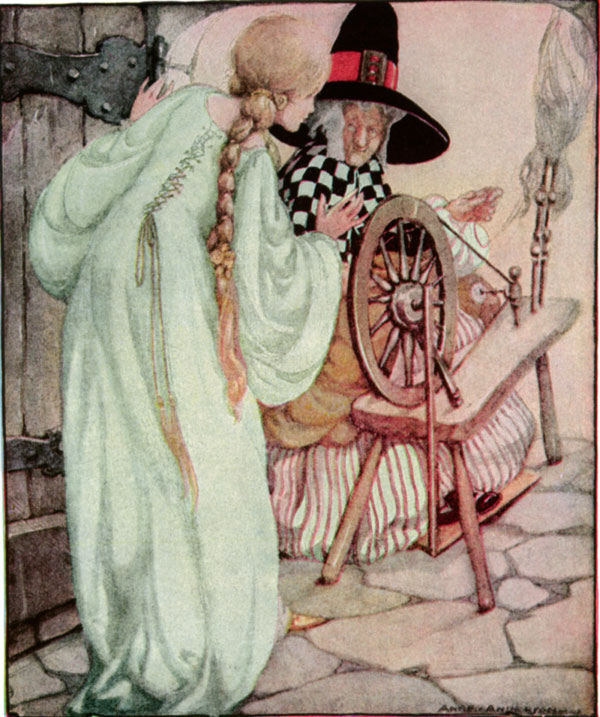
Sleeping Beauty; Old, Old Fairy Tales: Briar Rose by Anne Anderson. Aurora pricked her finger on the witches spindle

Sleeping Beauty; Old, Old Fairy Tales: Briar Rose by Anne Anderson. Aurora pricked her finger on the witches spindle
( Click image to enlarge)
A fairy tale is a type of short story that typically features folkloric fantasy characters, such as dwarves, elves, fairies, giants, gnomes, goblins, mermaids, trolls, or witches, and usually magic or enchantments. Fairy tales may be distinguished from other folk narratives such as legends (which generally involve belief in the veracity of the events described) and explicitly moral tales, including beast fables. The term is mainly used for stories with origins in European tradition and, at least in recent centuries, mostly relates to children's literature.
Read More » List of Fairy tales »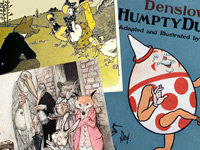
RESOURCES
This article uses material from the Wikipedia articles "List of fairy tales", "Fairy tale" and "Sleeping Beauty", which is released under the Creative Commons Attribution-Share-Alike License 3.0.
© Stories Preschool. All Rights Reserved.
